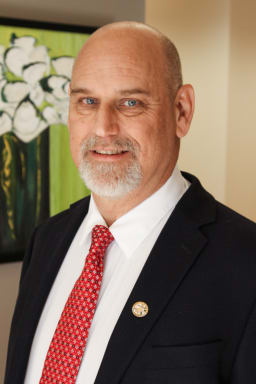Make it happen
UVA is down 69-64, and there is less than three minutes to play against Georgia Tech. If they lose, it would be the second straight going into their rivalry match with Virginia Tech. All that the Cavaliers worked for—their improbable standing atop the ACC, their favorable seed in the NCAA tournament—is at stake in this game, which has been dominated for the last 30 minutes by the Yellow Jackets. It’s time to make it happen.(1) Give J.R. Reynolds the ball.
 “Don’t just be a shooter,” Reynolds has been told repeatedly, and he’s taken the message. Here he shows his penetration skills, with the strength to finish strong for the old-fashioned three-point play. |
Reynolds sizes up the two defenders looking to stop him, fakes a pass to a teammate on the wing that momentarily draws away one defender—and cuts in between the pair of Yellow Jackets, squeezing in a layup as he’s hacked.
The ref blows his whistle. And one, baby.
“He’s going to play in the NBA,” says the guy next to me, over the eruption of the crowd clogging the John Paul Jones Arena for this nationally televised game.
“Jay-Ar-Reyn-Naulds” intone 5,000 student voices in unison. Reynolds steps to the line. A hush falls over the entire arena that’s eerie in an enormous room filled with 14,564 spectators—far closer to the 15,219 capacity than the original estimates of around 11,000 that athletic officials had banked on when the season began. But to this point, the Cavs have been surprise winners, with only one loss in the JPJ and not a single home-game loss in the ACC. Athletic officials didn’t bank on Reynolds and his backcourt companion Sean Singletary carrying this team this far this year in this league.
Reynolds eyes the basket, shoots. Right arm extending, wrist snapping in a motion that 82 percent of the time is right on the money, ball arching through the air.
Swish. Right on the money.
Georgia Tech still has a two-point lead, but that doesn’t last. They don’t score another point in the game while UVA picks up eight for the win, 75-69.
In his press conference after the game, Georgia Tech Head Coach Paul Hewitt credits that play by Reynolds with shifting the game. “That’s the one that got the momentum going,” says Hewitt.
A herd of reporters surround Reynolds after the game in the team’s film room, grilling him about his game-high 25-point performance (together with Singletary, they account for 65 percent of the team’s points). They ask about that specific play, the one Hewitt acknowledged, the one that made UVA fans across the country shriek and hoot and holler with unadulterated delight.
Reynolds doesn’t even remember it. The reporters describe it to him, tell him what Hewitt just said. But J.R. squints his eyes, shakes his head blankly and can’t figure out what they’re talking about. He is not trying to evade their questions; he is genuinely at a loss. Having played all but two minutes of the game, Reynolds was just doing what comes most comfortable to him—playing basketball.
Since ACC play began, no one has turned it up more than Reynolds. He averages 20 points a game in conference play, second in the ACC and the highest of any guard (Singletary is seventh on that list, at 17.7 points per game). His free throw percentage is third best in conference play, and he’s tied for fourth for number of treys made. During a game against Wake Forest in January, Reynolds scored 40 points. At the end of the regular season, he’s 12th on UVA’s all-time scoring list with 1,618 career points.
 Renowned for his high-octane approach to game coaching, Dave Leitao won ACC Coach of the Year honors this year after his team, picked to finish eighth, ended by tying for first in conference standings—largely thanks to the clutch play of Reynolds and Singletary. |
Most of us have a hard time imagining being in Reynolds’ position—tens of thousands of live eyeballs on your every move for 40 minutes, hundreds of thousands more eyes watching you on TVs at home or in bars or wherever else. But for Reynolds, it’s all about the moment on the court.
He struggles to explain this when asked, knows he can’t explain it. It’s as if all those people aren’t there, he says, as if it’s just him and the court and his teammates and opponents. Playing this game that he’s played ever since he can remember.
“Nothing else to do”
When James Richard(2) Reynolds was 5 years old, his mother, LaVerne Alexander, heard some racket coming from his room in their Roanoke apartment. “Go up and see what J.R. doing,” Alexander says she told her 12-year-old daughter Yudora.
What J.R. was doing was working on what he does so well now: shooting. Using a pair of socks as a basketball and a wire coat hanger as a hoop.
 Leprechaun-like Pete Gillen, UVA coach from 1998 to 2005, was at the helm for Reynolds’ first two seasons. When he was effectively sacked, Reynolds wondered, "Are we even going to have a basketball team?" |
Of course, socks and coat hangers in the bedroom does not a second team All-ACC basketball player make. His early years were also marked by games before school on the playground courts near his apartment. At first, he would just watch the big boys play. But sooner than one might think, he joined in, playing with his cousins who were years older than he.
They didn’t go easy on little J.R. Which meant that Reynolds quickly became a better defender, playing against these much bigger guys. He would lift weights with them to get stronger, he did shooting reps ad naseum to perfect his stroke.
“School might start at 7:30,” says Reynolds. “We’d be out there at 6:50, playing until school started, just a group of guys.” After school or on weekends, they would have two-on-two competitions, playing for five hours sometimes, playing best of 10 series (which could mean up to 19 games). “It would be crazy.”
“In my neighborhood, there was nothing else to do.”
As one grows older, however, there are other things to do, most of them not nearly as wholesome as running around on a court trying to get a ball through a hoop. But Reynolds’ skills and potential impressed AAU coach Delmar Irving,(3) who soon became a father figure for the kid who grew up with his mother and older sister.(4) When Reynolds’ grades slipped in the sixth grade, Irving arranged with Dick Wall, coach at the private school Roanoke Catholic, for Reynolds to transfer there. His mother (now remarried, her name is LaVerne Johnson) says she didn’t have to pay a dime.
At first, Reynolds didn’t like it, says Johnson, because he had to wear a uniform. But J.R. quickly got his grades back up, and Roanoke Catholic soon had a trio of Virginia Independent Schools Division II championships. Reynolds amassed 2,237 career points with Roanoke Catholic, was lauded by the press, and played on a junior national team in Germany during his junior season.
Reynolds was invited to a Nike basketball camp his sophomore year—serving in some measure as an exhibition for college recruiters scouting talent. Reynolds says that the Nike camps were the first time he thought he had a shot at the big leagues. His cousins had never been invited to Nike camps. He knew he needed to be serious about basketball now because of the scholarship opportunities it presented.
He committed early to the University of Virginia, thanks largely to the recruiting efforts of then assistant coach Tommy Herrion. Reynolds also made the decision quickly to alleviate some of the pressure to make up his mind. “You’re a kid,” Reynolds says. “You get tired of people calling.”
Despite his successes at Roanoke Catholic, Reynolds decided to spend his senior year elsewhere—at possibly the most prestigious basketball prep school in the country, Oak Hill Academy in Mouth of Wilson, Virginia. Over the years, the Christian boarding school in an isolated mountain town in Southwest Virginia had become a basketball mecca, producing more NBA talent than most top-flight college basketball programs, including such big names as Carmelo Anthony, Jerry Stackhouse and this year’s freshman phenom (and likely Player of the Year) Kevin Durant at the University of Texas. During the current season, the Oak Hill squad played games everywhere from Portland to Pittsburgh.(5)
At Oak Hill, Reynolds played with Isaiah Swann (now at Florida State) and Marcus Williams (now playing for the New Jersey Nets in the NBA). The trio lit up other teams and led Oak Hill to finish fourth in the national polls for the 2002-03 season.
The decision to go to Oak Hill caused some tension with Wall at Roanoke Catholic and sparked rumors that Reynolds was going to decommit from Virginia to look elsewhere. Herrion, who recruited him, had taken a job as head coach at the College of Charleston. UVA’s head coach at the time, Pete Gillen, came down to personally meet with Reynolds to make sure everything was still in good stead.
Was he looking elsewhere? “At the time I did,” Reynolds says. “Because it was after Tommy left. He was like the big reason I wanted to come here. I was second guessing myself.”
He knew he wanted the exposure of playing in the ACC and briefly considered switching to UNC. But Reynolds heard the rumors of a bad coaching situation brewing in Chapel Hill (Head Coach Matt Doherty was forced to resign at the end of the 2002-2003 season). So Reynolds chose what seemed a more stable environment at UVA.
Little did he know…
Escape from Shootersville
Reynolds won’t come out and say that his career isn’t everything he dreamed it would be. He will call it a “learning experience,” that he “went through a lot of ups and downs through the years,” describing it a “roller coaster.”
As Reynolds points out, those first two years were certainly not positive as far as winning games. J.R. made the freshman All-ACC team in 2003-04, but the UVA went 6-10 in the conference and lost in the second round of the NIT.(6) The next year was even worse: With a 4-12 ACC record, UVA didn’t even make the NIT. Gillen was forced out at the end of the season.
“It was just like, ‘What else is going to happen? Are we even going to have a basketball team?’” says Reynolds of that time. “I knew we were, but… So much stuff was going on.”
 Just before his final home game against Virginia Tech, J.R. Reynolds walks out to roaring applause with his mother, LaVerne Johnson (left), and his AAU coach Delmar Irving and his wife. |
The Gillen era, which started in 1998, looked to be off to a bang when Reynolds committed his junior year of high school. UVA made the NCAA Tournament in 2001, climbing at one point to No. 6 in the AP poll; though the Cavs lost in the first round of March Madness to Gonzaga, during the regular season they had knocked off No. 3 Duke and No. 2 UNC. Next season looked as good—UVA was ranked as high as No. 4—but the Cavs tanked down the stretch and didn’t return to the Dance. Roger Mason, Jr. went pro a year early, and Gillen would never regain his shine. The program became known for a low level of discipline and a defensive softness. Easy-going Gillen became notorious for taking time outs early and often, arguably keeping his team from developing the mental toughness to play through rough runs.
Dave Leitao was hired from DePaul because he was thought to remedy many of those problems. He brought a demonstrative style focusing on hardnosed defense and hustle plays. Camera crews love catching his yelling outbursts during time-outs and he was booted from a game against Hampton for kicking the scorer’s table and encouraging boos from the home crowd after the refs whistled a foul.
Leitao’s toughness seems to have done only good things for Reynolds.
“A guy like that when we met had come off some really great games as a sophomore,” says Leitao. “I thought he had a lot of talent, I thought he considered himself, and people around him considered him, a very good shooter—and I didn’t know a whole lot else. And when I watched him and saw films of him, I thought it was our job—both he and I—to expand himself.”
The warning to avoid the “shooter” label was nothing new to Reynolds. Roanoke is called Shootersville, Reynolds says, having produced three-point artists like J.J. Redick, who has the NCAA record for career three pointers, and Curtis Staples, who held the record until Redick broke it in 2006.
Staples, in particular, has been an example for Reynolds. Growing up in Roanoke, Reynolds watched Staples, who played at UVA from 1995 to 1998, in the gym. When Reynolds got to UVA, Staples visited with him, talking to him about how to handle basketball with college life. Those in Roanoke would tell Reynolds, “Don’t just be a shooter. Don’t just be like Curtis Staples.”
Despite such warnings, Leitao saw Reynolds falling into that trap. “I think, simply put, he was a shooter,” Leitao says, sometimes a shooter trying to make plays. “And I wanted him to be a player who could also make shots.”
Reynolds improved his passing game, his driving game, and particularly his defensive game—he now draws the toughest guard assignments. And Reynolds has gotten into shape.
“I thought back to that first workout we had last August when I first got here, not knowing if either [Reynolds or Jason Cain] was going to make it through a two-hour work out,” said Leitao in a press conference.
“He really really responded in all those areas.” Last month, Leitao did a bit of J.R. campaigning to reporters, saying that he’s been flying under the radar, despite being arguably the most consistent performer in league play.
Along with Singletary, Reynolds bought in early to the Leitao way. Undoubtedly that was
mutually beneficial—Leitao probably knew he wouldn’t get anywhere without having Reynolds buy in. While Singletary is visibly the leader on the floor, co-captain Reynolds is a key leader off the court, working to spend quality time with each of his teammates.
“J.R. is one of the best leaders I’ve been around,” says Tunji Soroye, a junior center originally from Nigeria. “He’s a leader, he’s a friend, he’s a teammate. He knows how to talk to us, he knows how to be there. He’s very caring. I noticed that from the first time I came down here.”
When Leitao’s toughness breaks down a player’s psyche, Reynolds is there to build it back up. “He tries to talk to the younger players in a way they understand,” says Adrian Joseph, a junior forward. “Coach may yell at us, and some of them might take the wrong message, so he breaks it down to the players and tells them what he really means.”
Into the sunset
During his senior night, against Virginia Tech, Reynolds has one of his worst shooting nights of the year, going 3 for 15 and picking up a mere 13 points (an awesome total for anyone on this team except him and Singletary). Unlike “make it happen” Reynolds, he seems to struggle to get in the zone. It is as if this time—the last time—he can’t ignore his surroundings, he must soak in the experiential details of playing to the home crowd.
UVA wins with surprising ease in the end, however, thanks in large part to somewhat uncharacteristic contributions from guys like Mamadi Diane and Jason Cain. Reynolds plays solid defense against the Hokies’ top scorer Zabian Dowdell.(7)
 Reynolds has always had basketball on the brain: His mother remembers J.R. wiring together a hoop from a coat hanger when he was 5 years old and shooting with a pair of socks. |
In the locker room after the game, Reynolds acknowledges that he had a hard time letting go: “I wasn’t really pumped up. Reality set in that this is my last game. It’s just like, ‘Man, where did time go?’” His eyes are watery, a wellspring of emotion trickling out from behind that normally stoic veneer of game-mode Reynolds.
Before the game, for the senior night honors, he walks out with his mother and his AAU coach, Delmar Irving and his wife, whom he calls his godparents. He receives a jersey in a frame, which he hoists along with Cain for thundering applause from the Cavaliers in attendance.
It is possibly the last time he will receive such thunderous applause.
Like any college senior, the future is right in his face, a mere two months off. But unlike most college seniors, he can’t think about it. He can’t arrange a job in his chosen field—basketball—until the season is over. And that won’t be over until the team loses in the NCAA Tournament—which could either be this weekend, or next weekend, or, if the Cavs have good luck and play well and miraculously make it to the Final Four, the beginning of April. According to NCAA rules, he can’t have any contact with agents or scouts until then.
Everyone around J.R. says he isn’t focused on that future—his NBA draft stock, his prospects abroad, anything.
“He never mentioned it, he never talk about it,” Joseph says. “I talk to him a lot, and he never mentioned anything about the NBA.” Johnson also says her son doesn’t talk about it.
“He’s definitely not thinking about that,” says Singletary. “Anytime you’re thinking about the future—even if it’s just the tournament, let alone the NBA—you’re going to struggle, your mind isn’t on the task at hand. And his mind isn’t on any of that stuff. He’s taking it day by day, taking care of his business day by day, taking care of his body, working on his game every day, and you can see out there, because he’s playing real free and real relaxed.”
In basketball, many are called and few are chosen. Only 3 percent of high school seniors playing basketball go on to play college basketball, according to the NCAA. Of those seniors playing college ball, only 1.2 percent play in the NBA—a league where more and more slots are reserved for foreign players. That means only 0.03 percent of those playing high school ball will make it to the NBA. Teachers across the country use that math to dissuade young men, particularly young black men, from banking on precisely what—to this point—J.R. Reynolds has managed to achieve.
The entire NBA process can be merciless and mercenary. Sports Illustrated’s Seth Davis recorded these notes on Reynolds from various pro scouts in January: “He’ll have a chance, but I see him as a volume shooter. I’d have a hard time coaching him because he wants to score. He looks to me like a two guard in a point guard’s body.”(8) NBADraft.net currently projects Reynolds going as the 25th pick in the second round—sixth from last in the draft. CollegeHoops.net puts Reynolds 10 spots higher, at 15th in the second round. ESPN.com’s Chad Ford only has Reynolds at 98 out of the Top 100 draft prospects, projecting him to go late in the second round or to be undrafted. Unless he somehow wows scouts in camps this summer, Reynolds will probably have to sweat it out on June 28, and possibly look to Canada, Europe or beyond.
Reynolds does not complain. He wants to play ball next year, yes, but he also wants to travel. He says he’s interested in the real estate business when he’s done with basketball.(9) But basketball is still a stress reliever, not a stress, even if it has been his ticket that lifted him from flunking sixth grade to graduating from UVA.
“It was always fun,” Reynolds says. “At the same time, I think I needed it as an outlet just to get through school. My mom, that’s one of the biggest reasons that I do this, for her. Just seeing her struggling sometimes, working two jobs, two-three jobs just to try to take care of me and my sister—that’s my motivation right there.”
At the end of the Georgia Tech game, Leitao said during his press conference, “We have two very very special players who at any point in time can make plays, and if you surround them with a team that plays defense you have a chance to win each and every night. …We’re going to keep riding [Reynolds and Singletary] until someone says we can’t ride it no more.”
Last week, the duo helped deliver ACC Coach of the Year honors to Leitao, along with first-team All-ACC honors for Singletary and second-team All-ACC honors for Reynolds. With a share of the ACC regular title, Virginia has ridden the play of J.R. Reynolds far beyond any reasonable expectations. The NCAA tournament will show just how much farther that can go. It will also mark the end for Reynolds, who has ridden the college game as far as it will take him.
footnotes:
(1)“Make it happen” is a nickname for Reynolds, I learn from his teammate Adrian Joseph. “That’s what we call him, because he always make something happen,” says Joseph. “When you say that, he’s going to know what you’re talking about.” Reynolds does know what I’m talking about when I ask—he bursts into as loud laughter as I ever hear from him—but he won’t divulge the origins of the expression. Joseph says that he also calls Reynolds “Peanut,” a crack on the size of his head.
(2) Reynolds won’t tell anyone what his middle initial “R” stands for, despite repeated requests from reporters. When I ask his mother, even she says, “J.R. going to kill me,” but gives up that it stands for Richard. What’s so wrong with Richard? Mama says that Reynolds considers it old-fashioned sounding. “You know how kids are nowadays about names.”
(3) AAU stands for Amateur Athletic Union, and it’s one of the best ways to get exposure as a basketball athlete. The AAU website has a list several hundred names long of “AAU alums” who played in the NBA. Irving has coached, among others, former Dukie J.J. Redick, who now plays for the Orlando Magic.
(4) Reynolds says he doesn’t keep in close touch with his father, Warren Reynolds, who still lives in Roanoke. “I talk to him when I see him,” Reynolds says. “It ain’t no hate or nothing, but I basically grew up with my mom. I’m close with a majority of people on my dad’s side.”
(5) Oak Hill also played a game this year at the John Paul Jones Arena. Hosting hot young talent is an easy way for college recruiters to show off their facilities and for that talent to show off their skills.
(6) Long the Class-A tournament for deciding national champions in basketball, the National Invitational Tournament (NIT) was eventually supplanted by the NCAA tournament. Now, it’s a stable for also-rans snubbed by the NCAA tournament committee.
(7) Dowdell in the end beats out Reynolds for first team All-ACC honors as the fifth place vote getter—J.R. is sixth. Reynolds keeps in touch with both Dowdell and his teammate in the backcourt, Jamon Gordon. When I ask after the Tech victory if Reynolds will rub in the win, Reynolds dismisses the id
ea: “We might see them in the ACC tournament.”
(8) Reynolds’ favorite NBA player is Chauncey Billups, an appropriate choice considering the scouts’ comments. Billups is roughly the same size as J.R. and is also a dual point/shooting guard. As Reynolds says, Billups is “underrated” and “shows up in big games.”
(9) Following once again in the footsteps of Curtis Staples, who is reportedly a real estate mogul in the Lynchburg area.




